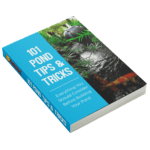To an untrained or inexperienced eye, a natural pond seems like little more than a natural “tub of water”. That is, water – mostly from rain or runoff – collects into a small body of water. This then “magically” turns into an acceptable ecosystem for plant and animal life to live in.To an average person, the need to know how a pond regulates itself is relatively useless information. However, when someone wishes to duplicate a manmade pond on their property, the passive witnessing of nature may not be enough. Instead, it becomes important to understand the cyclical process that maintains the pond’s aforementioned ecosystem. This includes understanding the pond’s nitrogen cycle.
And what is a pond’s nitrogen cycle? A ponds nitrogen cycle is a series of steps that take place in a pond that helps to keep the pond clean and cycle out organic waste. Here is a simple break down of it.
In a fish pond, fish will release waste into the water. As the waste breaks down, ammonia is produced. Ammonia can be toxic if it builds up. To keep ammonia levels from getting to dangerous levels, beneficial bacteria called Nitrosomonas will break down ammonia and convert it into Nitrite, which is still toxic if it builds up, but less so than Ammonia. After the Ammonia is converted to Nitrite, another group of beneficial bacteria called Nitrobacter will in break down and convert Nitrites into Nitrates, which are far less toxic than Nitrites. This Nitrate is then utilized by the plant life in the pond as a source of nourishment, which helps to keep the Nitrate level low and can also help with controlling algae. So, the nitrogen cycle is essentially the amazing way a pond’s ecosystem cleans itself of harmful toxins and creates sustaining nourishment within its environment.
This natural process was developed over many years of evolution and is the way it should work in a naturally balanced pond. However, manmade ponds sometimes require assistance from pond products to tip the ecosystem odds in favor of pond life survival. Pond filters can help filter out extra waste and also provide a safe breeding ground for beneficial bacteria to grow and thrive. There are also bacteria inoculants on the market that can be added regularly to ensure that proper levels of beneficial bacteria are present to help break down waste and to help convert ammonia and nitrites. Additionally, pond plants can be purchased and added to a pond to help with the utilization of un-necessary nitrates to prevent its availability to nuisance plants like algae. All of these products can assist a small fish pond environment with establishing a proper and efficient nitrogen cycle.
Over time, the need to take special steps to maintain a pond’s nitrogen cycle will decrease. This is because the pond will become self-sufficient and able to produce and feed adequate amounts of bacteria that fish waste ammonia is no longer a threat. As the saying goes, nature eventually takes care of itself.


